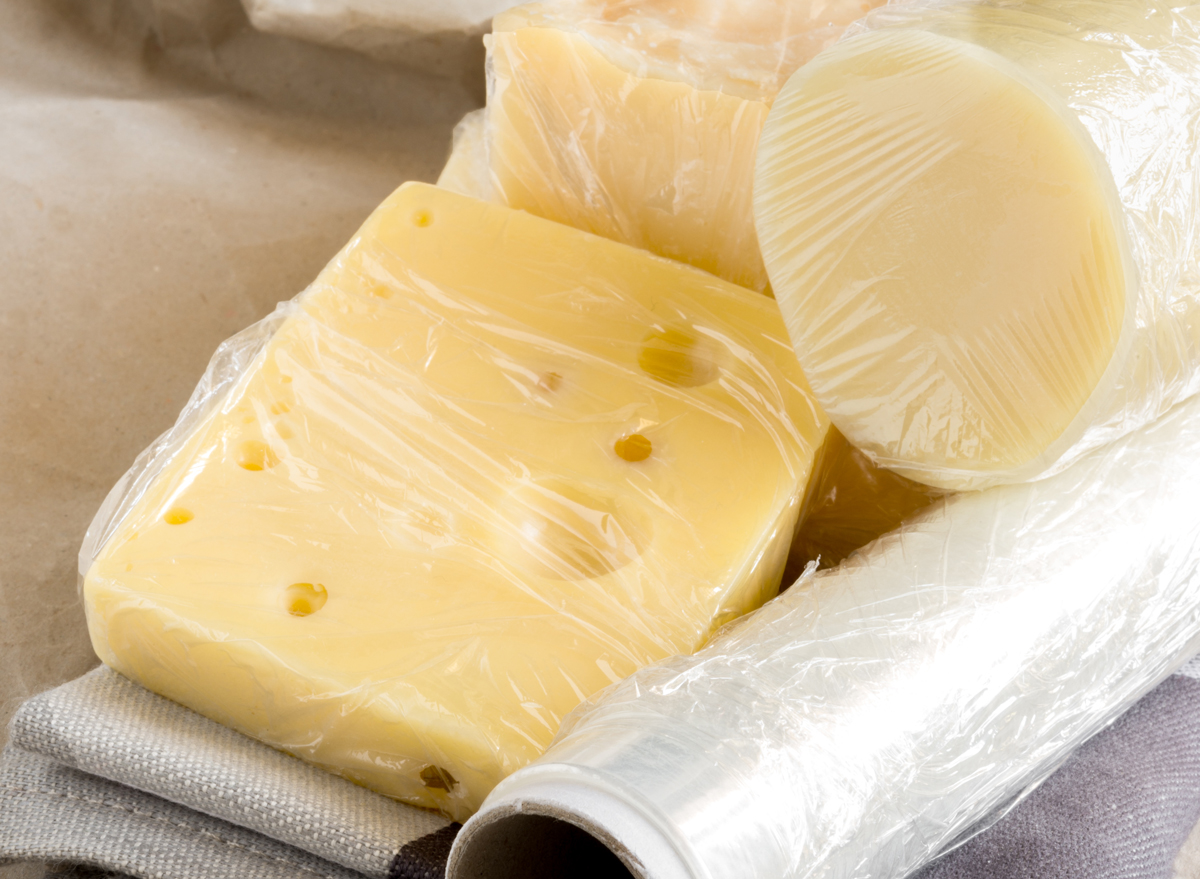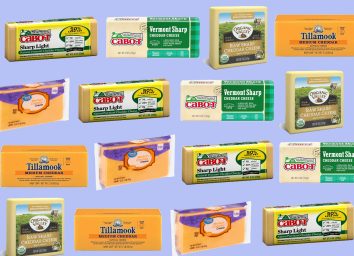You've Been Storing Cheese Wrong Your Whole Life

Do you make a beeline to the charcuterie board at parties? Are you always the first person to schedule wine and cheese nights? Do you drool over videos of ooey, gooey, stretched cheese? Then it's confirmed: you're a cheese fanatic. But despite your love of all things cheese, we're sorry to tell you that you've probably been storing cheese wrong your entire life. The good news is that it's not a big deal, because we're about to teach you how to store cheese properly so it lasts longer, maintains flavor, and doesn't have to end up molded in the garbage.
We reached out to cheese experts to find out the common mistakes people make when storing cheese, the proper way to store cheese, and the best tools you need to keep cheese fresh. To keep even more foods besides cheese fresh, you're going to want to invest in these 14 Best Kitchen Tools for Helping Food Stay Fresh.
Why storing cheese in plastic wrap is a huge mistake
Yes, many cheeses you buy come wrapped in plastic wrap. And yes, you use plastic wrap to store most of your leftovers without a problem. But storing cheese in plastic wrap is the worst thing you can do if you want to keep your cheese fresh.
"Plastic wrap is by design a full barrier, and cheese needs air and humidity to breathe," says Joey Wells, Global Senior Coordinator for Specialty Cheese Product Innovation and Development at Whole Foods Market. "Additionally, cheese can act as a sponge, absorbing the plasticizers that give plastic wrap its ability to stretch and cling, which you don't want. Both of these issues affect the flavor of cheese and also suffocate it, causing it to lose shelf life."
So if you shouldn't use plastic to store cheese, what should you use to extend its shelf life?
The best tools to store cheese
Beeswax, parchment paper, wax paper, glass containers…
"There are a variety of ways to store cheese and no single way is necessarily correct," says Venae Watts, a fifth-generation member of America's oldest family-owned creamery, Minerva Dairy.
So let's take a look at every way experts recommend you can store cheese:
- Specialty cheese paper: "When storing cheese, specialty cheese paper and bags are best. Specialty paper is a two-ply product that allows cheese to breathe while maintaining humidity," says Wells. "One cheese-wrap outfitter, Formaticum, uses a two-ply material—wax-coated paper lined with thin, porous polyethylene plastic—in both its Cheese Paper and Cheese Bags. This combination (often used by professional cheesemongers) lets moisture wick off the cheese but not escape entirely," says Lisa McManus, the Executive Tasting & Testing Editor at America's Test Kitchen.
- Parchment or wax paper: "If [specialty cheese paper] is not available, you can loosely wrap your cheese with parchment or wax paper, which still protects it from drying, while keeping it exposed to the air and humidity it needs," says Wells.
- A cheese dome: "This allows the cheese to create its own temperature and humidity. In essence preserving the cheese in its own atmosphere," says Watts. "These domes have proven themselves year after year and also make for great kitchen decor."
- Vinegar: Surprising, but true. "Putting a small amount of vinegar onto cheesecloth or a paper towel before storing your cheese will help save it from mold. The vinegar acts as a kind of barrier and kills mold," says Watts. "You may be thinking your cheese will taste like vinegar when you go to eat it, but it won't."
STAY INFORMED: Sign up for our newsletter to get the latest food news delivered straight to your inbox.
Can you store cheese in its original packaging?
The short answer: no. In fact, cheese experts go so far as to say that not only should you avoid storing cheese in its original packaging, but you should also rewrap cheese immediately when you get home.
"Cheese that's wrapped in plastic should be re-wrapped in fresh, clean cheese paper when stored," says Wells.
The answer gets a bit more complicated depending on the cheese and the original packaging it comes in.
"Some cheeses may come in a thin wood or cardboard package with a porous plastic overwrap, such as Epoisses. Keeping the cheese in these packages is fine until you open them. Then, it's recommended that you store any remaining uneaten cheese in a fresh piece of cheese paper," says Wells.
How to store cheese to keep it fresh, preserve flavor, and prolong shelf life:
First thing's first: before you store your cheese, make sure your hands are clean. "The most important thing about handling cheese is that you start with clean hands and clean kitchen tools. If handled properly with clean hands and clean utensils, you can really mitigate mold growth by reducing the introduction of bacteria," says Amanda Freund, Cabot Creamery Cooperative Farmer.
Then, a little background on the science of storing cheese: "Keeping cheese fresh in the refrigerator is tricky," says McManus. "As cheese releases moisture, tight wrappings encourage mold; loose ones let it dry out and harden."
To find a method and product that strikes the delicate balance, America's Test Kitchen tested methods of storing cheese.
- Firm cheeses: "Our DIY method is to double wrap pieces of cheese, first with parchment and then with aluminum foil," says McManus. The parchment paper allows the cheese to breathe, allowing the moisture to wick off the cheese. Then, the aluminum foil prevents the moisture from escaping.
- Soft cheeses: "Soft cheeses with delicate rinds, like Brie and Camembert, need plenty of air around them so that their rinds can breathe," says Tenaya Darlington, also known as Mme Fromage, a cheese expert and author of the cheese guide, DiBruno Bros. House of Cheese. "I like to unwrap them and drop them into a glass container lined with a paper towel (it will absorb any condensation), then leave the lid open just a smidge so air can circulate," she says.
- Brined cheeses: "I recommend that cheese purchased in brine, should be kept in its brine," says Wells.
Do you have to rewrap cheese every time you use it?
It may be a pain, but you'll have to follow these guidelines more than once: "Rewrap remaining cheese in a new sheet of cheese paper each time you cut off some of the cheese. Again, record the name of the cheese and the date on the outside of the paper," says Wells.
Now that you know how to store cheese, the last thing to learn is where to store cheese.
Where should you store your cheese?
If you've been storing your cheese on the top shelf of your refrigerator for easiest access (you never know when a brie craving will hit!) you've been doing it wrong.
When storing your cheese in the fridge, "I recommend keeping it in a drawer in your refrigerator since those areas are usually a little warmer," says Watts. "Cheese likes to be stored at between 40 and 50° F, which is why the coldest part of your refrigerator will likely be too cold!"
Besides the fact that the crisper drawers have a more moderate temperature, Wells shares that the crisper drawer has another hidden benefit: it protects the humidity cheese needs to breathe.
Now that you know how to store cheese properly, learn how to use it in these 13 Delicious Ways to Upgrade Your Mac and Cheese.








